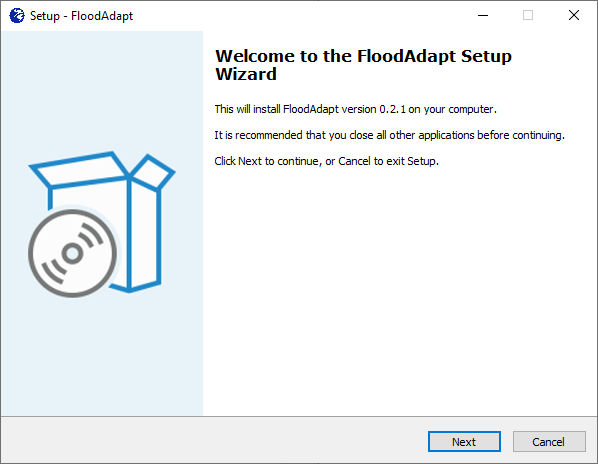Getting Started
This section covers system requirements for running FloodAdapt, initial installation steps, opening FloodAdapt, and the FloodAdapt database folder structure.
System requirements
In order to run FloodAdapt, the following are required:
- Your computer must be running a Windows operating system.
- The first time the FloodAdapt application is opened must be by a user with administrative rights
- The computer must have access to the internet
- At least 2 GB of storage for the FloodAdapt system files and the underlying database
- Approximately 150 MB of storage for each user-generated scenario
FloodAdapt has been tested on Windows 10 and 11. It is expected to work on older systems, but has not been tested.
Installation steps
To download and install FloodAdapt on your computer:
- Download the FloodAdapt installer from the Deltares USA website.
- Double-click the “FloodAdaptInstaller” file and the setup wizard will open (see Figure 1). Follow the steps of the installation wizard.
Opening FloodAdapt
When you open the FloodAdapt application you will be prompted to select a database root folder. This is the location where you store one or more FloodAdapt databases. Once you select a root folder, the databases within the root folder will appear. Select the database you want to work with and click “Start” to open the FloodAdapt application. Each time you open FloodAdapt you have the opportunity to change the database root and/or select a different database.
The FloodAdapt application is a calculation “shell” that requires a FloodAdapt database to work. Details on setting up a FloodAdapt database in a new location are provided in the Setup Guide.
FloodAdapt database
The FloodAdapt database uses a normal folder structure so that it is easily accessible by users, without requiring database knowledge. Figure 3 shows the overall folder structure. The “Database Root Folder” is folder where you can store one ore more FloodAdapt site databases. Within each site database, there are three folders: Input, Output, and Static. The input and output folders are populated when you use the FloodAdapt application. The input folder contains information about scenario components: events, projections, measures, strategies and scenarios. The output folder contains the flooding and impact output from simulated scenarios, and is described in more detail in the Output section. The Static folder contains information that is prepared when setting up FloodAdapt for a particular site location (see the Setup Guide).


